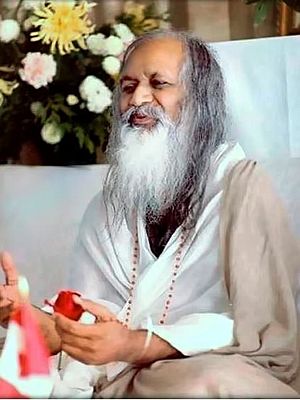Transcendental Meditation facts for kids
The Transcendental Meditation technique, often called TM, is a special way of meditation. It was created by a teacher named Maharishi Mahesh Yogi. Today, the name "Transcendental Meditation" is a registered trademark.
People practice this meditation while sitting down with their eyes closed. It is usually done twice a day, once in the morning and once in the evening. Some studies show that it can help people relax and reduce stress.
Contents
How to Learn Transcendental Meditation
Learning the Transcendental Meditation technique happens in a few steps. First, there are two talks and a personal chat. After that, you have a session where you learn the meditation method itself. Then, in three more sessions, a teacher checks to make sure you are doing the technique correctly.
What is the Goal of TM?
The main goal of the Transcendental Meditation technique is to help people feel calm and rested. The idea is that you can carry this feeling of deep rest and comfort with you into your everyday life. This means you can feel peaceful even when you are busy.
The Story of Transcendental Meditation
In 1955, Maharishi Mahesh Yogi, whose birth name was Mahesh Prasad Varma, started teaching a meditation method. He said this method was based on ancient Indian texts called the Vedas. He named this new way of meditating "Transcendental Meditation."
Before this, Maharishi had studied with his own teacher, Swami Brahmananda Saraswati. He was also his teacher's secretary from 1941 until 1953. In 1957, Maharishi started a group called the Spiritual Regeneration Movement in Madras, India. This happened on the last day of a festival honoring his teacher.
Starting in 1958, Maharishi began traveling around the world. He taught the TM technique to many people in different countries. In the early 1970s, he aimed to create many teaching centers. He wanted one center for every million people in the world.
In 1990, Maharishi moved to Vlodrop, a town in the Netherlands. There, he started an organization called The Global Country of World Peace. This group now manages all the teaching of the Transcendental Meditation technique worldwide. The Global Country of World Peace says that over 6 million people around the world have learned TM.
How TM Might Affect Your Body
Scientists have been researching Transcendental Meditation since 1970. One of the first studies, done in 1970, showed that during TM, the body rests very deeply. It's a deep rest, but you are not asleep; you stay alert. This study also suggested that TM could help reduce stress.
Some studies have looked at whether TM helps improve a person's overall health. One study found that TM did not offer more health benefits than simply learning about health education.
TM, Religion, and Group Behavior
Websites about Transcendental Meditation often say that the technique does not interfere with a person's religion.
In 2013, a religious leader named Monsignor Raffaello Martinelli said that Christians could learn from other religious traditions for their own Meditation. He mentioned things like zen, yoga, controlled breathing, and Mantra. He explained that if the Catholic Church finds truth and holiness in other religions, it's okay to use helpful parts from them. However, he stressed that these practices must always fit within the Christian idea of prayer.
In 1984, Cardinal Sin, an Archbishop in the Catholic Church, said that the Transcendental Meditation technique did interfere with Christian religions. However, other religious leaders believe that the technique does not cause problems with religious beliefs or practices.
Some experts who study groups that act like cults have suggested that people who use the Transcendental Meditation technique might show cult-like behaviors. On the other hand, David Orme-Johnson, a psychologist and researcher, has a different view. He was once a professor at Maharishi University of Management. He says that studies show people who use the TM technique act like independent and responsible adults. He believes they do not act in the way people in cults are often described.
|
See also
 In Spanish: Meditación trascendental para niños
In Spanish: Meditación trascendental para niños



